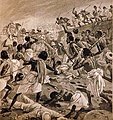Portal:Somalia
WELCOME TO THE SOMALIA PORTAL!Camels on sale at Baidoa livestock market in Somalia on November 7, 2019
Somalia, officially the Federal Republic of Somalia is a country located in the Horn of Africa. It is bordered by Ethiopia to the west, Djibouti to the northwest, the Gulf of Aden to the north, the Indian Ocean to the east, and Kenya to the southwest. Somalia has the longest coastline on the mainland of Africa, with a seaboard that stretches 3,025 kilometres (1,880 mi). In antiquity, Somalia was an important centre for commerce with the rest of the ancient world, it is among the most probable locations of the fabled ancient Land of Punt. During the Middle Ages, several powerful Somali empires dominated the regional trade, including the Ajuuraan Sultanate, the Adal Sultanate and the Geledi Sultanate. In the late nineteenth century, through a succession of treaties with these kingdoms, the British and Italians gained control of parts of the coast, and established British Somaliland and Italian Somaliland. In the interior, the Dervish State wherein Muhammad Abdullah Hassan was leader successfully repulsed the British Empire four times and forced it to retreat to the coastal region. Italian occupation lasted until 1941, yielding to British military administration. British Somaliland would remain a protectorate, while Italian Somaliland in 1949 became a United Nations Trusteeship under Italian administration, the Trust Territory of Somaliland. Though, in 1960, the two regions united to form the independent Somali Republic under a civilian government. In 1991, following the collapse of the government of Siad Barre, the Republic of Somaliland unilaterally declared its independence from Somalia, reinstating the borders of former British Somaliland, and has been governed by democratically elected leaders since. Somaliland's independence, however, has not been recognised by any foreign country or international organisation. Somalia has a population of around 10 million. About 85% of local residents are ethnic Somalis, Somali and Arabic are the official languages of Somalia, both of which belong to the Afro-Asiatic family. Most people in the territory are Muslims, the majority being Sunni. Selected article -The Ogaden War, also known as the Ethio-Somali War (Somali: Dagaalkii Xoraynta Soomaali Galbeed, Amharic: የኢትዮጵያ ሶማሊያ ጦርነት, romanized: ye’ītiyop’iya somalīya t’orinet), was a military conflict fought between Somalia and Ethiopia from July 1977 to March 1978 over the sovereignty of Ogaden. Somalia's invasion of the region, precursor to the wider war, met with the Soviet Union's disapproval, leading the superpower to end its support for Somalia to fully support Ethiopia instead. Ethiopia was saved from defeat and permanent loss of territory through a massive airlift of military supplies worth $1 billion, the arrival of more than 12,000 Cuban soldiers and airmen and 1,500 Soviet advisors, led by General Vasily Petrov. On 23 January 1978, Cuban armored brigades inflicted the worst losses the Somali forces had ever taken in a single action since the start of the war. (Full article...)This is a Good article, an article that meets a core set of high editorial standards.
The Embassy of the United States of America to Somalia is a diplomatic mission of the United States in Mogadishu, Somalia from 1960 to 1991. In 1957, the US opened a consulate-general in Mogadishu—the capital of the Trust Territory of Somalia, a UN trusteeship under Italian administration. The consulate was upgraded to embassy status in July 1960, when the US recognized Somalia's independence and appointed an ambassador. The embassy served to counter Soviet influence during the Cold War and also served as a base for the United States Agency for International Development, which had a large presence in the country. In 1989, the embassy moved from a dilapidated building in central Mogadishu to a new compound on the outskirts of the city. Violence quickly enveloped the city in late December 1990, during the Somali Civil War, and on 1 January 1991, the ambassador contacted the State Department to request the closure and evacuation of the embassy. Approval was given the following day, but violence and the collapse of the central government prevented the US, and several other countries, from airlifting their diplomats and civilians through Mogadishu International Airport. USS Guam and USS Trenton, which were stationed off the coast of Oman, were dispatched to airlift staff from the embassy; American civilians and many foreign diplomats also gathered at the embassy, seeking evacuation. The embassy closed on January 5, 1991, and 281 American and foreign diplomats and civilians were airlifted by helicopter from the embassy compound to Guam and Trenton. (Full article...)Related portalsDid you know -
Selected image -Wiki Loves Africa in Somalia images
CategoriesGeneral images -The following are images from various Somalia-related articles on Wikipedia.
TopicsAssociated WikimediaThe following Wikimedia Foundation sister projects provide more on this subject:
Things you can do
External mediaSources for additional Somalia news
SourcesDiscover Wikipedia using portals | ||||





































































































